| |
Architecture

The architecture of South Africa mirrors the vast ethnic and cultural diversity of the country and its historical colonial period. In addition, influences from other, distant, countries, have contributed to the variety of the South African architectural landscape.
Herbert Baker, among the country's most influential architects, designed the Union Buildings in Pretoria. Other buildings of note include the Rhodes memorial and St George's Cathedral in Cape Town, and St John's College in Johannesburg.
Cape Dutch architecture was prominent in the early days (17th century) of the Cape Colony, and the name derives from the fact that the initial settlers of the Cape were primarily Dutch. The style has roots in mediaeval Holland, Germany, France and Indonesia. Houses in this style have a distinctive and recognisable design, with a prominent feature being the grand, ornately rounded gables, reminiscent of features in townhouses of Amsterdam built in the Dutch style.
The rural landscape of South Africa is populated with traditional African architecture .
South Africans have been referred to as the 'rainbow nation', a title which epitomises the country's cultural diversity. The population of South Africa is one of the most complex and diverse in the world. Of the 45 million South Africans, nearly 31 million are Black, 5 million White, 3 million Coloured and one million Indian. The population density is 32.9 people per km².
The Black population is divided into four major ethnic groups, namely Nguni, Sotho, Shangaan-Tsonga and Venda. There are numerous subgroups of which the Zulu and Xhosa (two subgroups of the Nguni) are the largest. The majority of the White population is of Afrikaans descent (60%), with many of the remaining 40% being of British descent. Most of the Coloured population live in the Northern and Western Cape provinces, whilst most of the Indian population lives in KwaZulu Natal.
The Afrikaner population is concentrated in the Gauteng and Free State provinces and the English population in the Western and Eastern Cape and KwaZulu Natal. There are eleven official languages in South Africa, namely English, Afrikaans, Ndebele, Sepedi, Xhosa, Venda, Tswana, Southern Sotho, Zulu, Swazi and Tsonga. View more information about each (see below), including the origins of the language and where it is spoken in South Africa. Also see South Africanisms and useful Xhosa phrases and Zulu phrases.
|
| |
South Africa's Official Languages
 
Xhosa (isiXhosa) Language
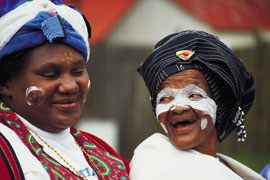 
Xhosa Ladies
There are 11 official languages in South Africa and Xhosa is known to be listed as one of those languages. Approximately 18 percent of South Africa’s population speaks the language, and when doing the maths, that makes it around 7.9 million people.
Xhosa is marked by a number of tongue-clicking sounds. Those that speak the language are usually involved in an ethnic group known as the amaXhosa, and to them this language is known as isiXhosa. An interesting fact is that the word “Xhosa” is derived from the Khoisan language, which means “angry men”. A majority of the languages in South Africa which involve tongue-clicking, originate from the Khoisan. Xhosa is known to fall under Bantu language, and is also a representative of South-western’s Nguni family. With this fact, South Africa’s known to be Xhosa’s native land, and especially the Eastern Cape - where the language is spoken everywhere. The Zulu people of South Africa have their own name for the Xhosa people, and this is KwaXhosa. When translated KwaXhosa simply means “land of Xhosa”. Visiting the Western Cape and Gauteng one will also see many Xhosa people and hear them speak. Because Xhosa and Zulu are both classed as a Bantu language, if these two classes were to communicate with one another, often they will understand each other.
 
Xhosa is unusual, at the same time it is an attractive sounding language. To many, the language is difficult to learn mainly because the consonants are uncommon and also densely populated. The sounds are aggressive, which consists of English sounds, 15 clicks, ejectives and also an implosive. What learners battle with are the 15 clicks, and these are divided into 3 groups: the dental clicks - where the tongue presses against the person’s teeth. The end result should be “tut-tut”, alveolar clicks – where the tongue presses against the palate. The end result should be a sound resembling cork popping out of a bottle, and then the lateral click - where the tongue presses against the side of the mouth. The end result should be the sound one makes when calling a horse.
Learning to speak the language can be very challenging, but also very rewarding. The next time you decide to travel to South Africa’s Eastern Cape don’t forget to stop an amaXhosa and ask him / her to instruct you on a couple of phrases. There is no doubt that they will be eager to teach you a thing or two and share their historical language with you.
   
|
| |
 
Zulu (IsiZulu) Language
IsiZulu or Zulu is one of the official languages of South Africa. 10 million people speak the language and most of these people live in South Africa.
24% of South Africans, Zulu is considered to be their home language and 50% of the South Africa’s inhabitants understand the language. Zulu falls under the Nguni group and is one of the Bantu languages. Xhosa and Zulu are the only two languages mutually understandable. The Zulu nation came into existence around the 14th century. Although there are many Bantu migrants, back then Zulu language adopted many of the sounds that make up the language from the San and from the Khoi. The San and the Khoi were the first residents in South Africa. Evidence of this is the Zulu’s clicking consonants used in their language. Other indigenous languages before were all oral languages until missionaries from Europe arrived. This was the time Zulu became written - when missionaries that had arrived jotted down the interesting facts concerning this language using a Latin alphabet. The year was 1883, and this was the year the first book containing the Zulu language was produced - A Bible.
John Dube resided in Natal at the time established what was called Ohlange Institute in the year 1901. The Ohlange Institute was known to be South Africa’s very first educational foundation. John Dube was considered a great pioneer in the Zulu language and wrote the first Zulu paperback titled “Insila Kashaka”.
Other names in Zulu literature had included Oswald-Mbuyiseni Mtshali, Reginald Dhlomo and Benedict-Wallet Vilakazi. The mentioned novelists specialised in creating historically-based novels telling the life stories of known Zulu leaders - Dingane and Shaka (also known as Shaka Zulu). Zulu anthologies came into production in the year 1935 and in the later years with writers JC Dlamini, BWV Vilkazi and OEH Nxumalo. Written Zulu today is under Kwazulu Natal Zulu-Language Jurisdiction Board.
   
Zulu is now a language that has become wide spread in Africa. It is especially spoken in KwaZulu Natal, which is also known as “Land of-the Zulu”. The language can also be heard in Mpumalanga and Gauteng. Other countries in Africa where this language is spoken are Swaziland and Lesotho, which are also South Africa’s very close neighbours.
South African English has adopted many Zulu words into its vocabulary. Some of the words include ubantu (humanity), donga (ditch), indaba (conference) and muti (medicine). Two Zulu animal names are used in Standard English, and these are the Impala (proper name) and the Mamba (poisonous snake). If you are considering learning a South African language, Zulu would probably be suggested by many. The main reason is that the language is not difficult to understand and it is widely used and understood.
        
|
| |
 
 Afrikaans Language Afrikaans Language
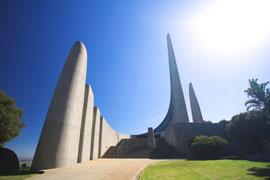 
Afrikaans Language Monument outside Paarl
 The Afrikaans language is one of South Africa’s official languages and a majority of South Africa’s population uses this as their first or second language. Afrikaans is a born language and attached is a fascinating history. The language is widely spoken in Namibia and spoken partly in Zimbabwe, Botswana and other countries. According to many English South Africans, Afrikaans is said to be a language that is dying, but this language has made its mark in society and the culture backing this language is rich. The Afrikaans language is one of South Africa’s official languages and a majority of South Africa’s population uses this as their first or second language. Afrikaans is a born language and attached is a fascinating history. The language is widely spoken in Namibia and spoken partly in Zimbabwe, Botswana and other countries. According to many English South Africans, Afrikaans is said to be a language that is dying, but this language has made its mark in society and the culture backing this language is rich.
 The word Afrikaans in Dutch means “African”. Afrikaans was created in Cape Town, which is home to various nationalities. The nationalities that make up the population of South Africa are Indonesians, Madagascans, Khoikoi, Dutch Settlers and West Africans. Afrikaans has become a new form of Dutch. Afrikaans’s original dialect is referred to many as Kitchen Dutch, Cape Dutch or African Dutch. In the late 19th century Afrikaans was recognised as the separate language when Dutch was considered. 1961 was the year when Afrikaans became one of the 11 official languages with English. This gave the Dutch language the boot straightaway, although many people still speak the language around the country. The word Afrikaans in Dutch means “African”. Afrikaans was created in Cape Town, which is home to various nationalities. The nationalities that make up the population of South Africa are Indonesians, Madagascans, Khoikoi, Dutch Settlers and West Africans. Afrikaans has become a new form of Dutch. Afrikaans’s original dialect is referred to many as Kitchen Dutch, Cape Dutch or African Dutch. In the late 19th century Afrikaans was recognised as the separate language when Dutch was considered. 1961 was the year when Afrikaans became one of the 11 official languages with English. This gave the Dutch language the boot straightaway, although many people still speak the language around the country.
 
 South African School Children South African School Children
What make Dutch and Afrikaans different are grammar and the vocabulary. Afrikaans is considered to be a language containing “regular” grammar. This is ascribed to certain influences by Dutch-creole languages. A huge sum of vocabulary shows evidence of South-Hollandic Dutch origins. The Afrikaans language does contain words from English, Khoi, Xhosa, Asian Malay, Malagasy, San, Portuguese and French, although many of these words do sound extremely and noticeably different. The dialect in the North-eastern was a form of Afrikaans, and from this written-standard was developed. Afrikaans is spoken as a first language by 60 percent of white people and about 90 percent of coloured people. Many South African races use Afrikaans as their second language, and many black South Africans use it as their third language.
 Afrikaans has been labelled by many critics as a very "ugly language", but apart from this the language has gained popularity in many countries in the world. Universities in Belgium, Netherlands, Germany, Austria, Russia and Poland are also teaching Afrikaans. In the year 1975 the Afrikaans-Language Monument (photo above) was built near the town of Paarl in the Western Cape. The structure was extremely impressive and was created to remember the statement of Afrikaans for being a language on its own. Afrikaans has been labelled by many critics as a very "ugly language", but apart from this the language has gained popularity in many countries in the world. Universities in Belgium, Netherlands, Germany, Austria, Russia and Poland are also teaching Afrikaans. In the year 1975 the Afrikaans-Language Monument (photo above) was built near the town of Paarl in the Western Cape. The structure was extremely impressive and was created to remember the statement of Afrikaans for being a language on its own.
The Afrikaans language had definitely made its mark, and if you are unable to learn a phrase or two when visiting this country ... "môre is nog 'n dag" (tomorrow is another day) or plainly: the opportunity will always be there.
  
|
| |
 
 This language known as Luvenda, Venda or Tshivenda, originated from the Bantu language and is also related to Niger and Congo languages. Those that speak Venda are part of South Africa’s population, and it is one of the 11 official South African languages. This language known as Luvenda, Venda or Tshivenda, originated from the Bantu language and is also related to Niger and Congo languages. Those that speak Venda are part of South Africa’s population, and it is one of the 11 official South African languages.
 Around 666 000 of Tshivenda speakers live in the Northern parts of South Africa’s Limpopo Province. Those that speak Tshivenda have a Royal Family and there are also traditions that relate to this. Around 666 000 of Tshivenda speakers live in the Northern parts of South Africa’s Limpopo Province. Those that speak Tshivenda have a Royal Family and there are also traditions that relate to this.
If the son wants to become a Chief or a King, the son’s mother must be “legible”, and only this way will the son sit on the throne of his dearly departed Chief or King. Mothers are required to be part of the Royal Family and this will promise that children have royal blood. The Tshivenda culture allows a sister and a brother from different mothers to marry. This is another promise that only royal blood will take the throne.
 The people of Tshivenda show women the greatest respect, and because of this women are allowed to become Queens and Chiefs of their tribes. Followers show the Tshivenda women the same great respect, and in turn they show respect to their fellow males. The people of Tshivenda show women the greatest respect, and because of this women are allowed to become Queens and Chiefs of their tribes. Followers show the Tshivenda women the same great respect, and in turn they show respect to their fellow males.
 In the Tshivenda tradition, a Khoro takes place every Sunday. This is a Tshivenda Tribal Council. Here Chiefs and senior citizens get together and have discussions concerning the community. The Tshivenda people are very proud of all their traditions and introduce their standards and morals every new generation. In the Tshivenda tradition, a Khoro takes place every Sunday. This is a Tshivenda Tribal Council. Here Chiefs and senior citizens get together and have discussions concerning the community. The Tshivenda people are very proud of all their traditions and introduce their standards and morals every new generation.
Music is one of the most important activities in the life of a Tshivenda person. They have music for every event in their lives. There is music for worship, sadness, joy, work and sadness. Drum beats accompany most of their music, and exceptions are made for songs, and the songs are usually murmured. Drums are extremely important for the Tshivenda people, making it symbolic. The Tshivendas dance to the beat of their drums, and this is the peoples’ different changes through life.
Cooking is done in a traditional way, and usually by the Tshivenda speaker. The traditional meal is Tshidzimba, which is a mixture of groundnuts, beans and mielie grains. Summer is the time the Tshivenda people plant seeds, and this is also known to be the best time when they work. There is always something for the hard-working people to look forward to after working all day in the fields and that is music, a few drinks and dancing.
    
|
| |
 
Ndebele Language
|
| |
 
Sepedi (Northern Sotho) Language
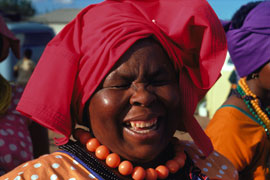 
Sepedi Woman
Sepedi is also sometimes referred to as Sesotho sa Laboa or Northern Sotho. The language of Sepedi is spoken by approximately 4,208,980 individuals and it is one of the eleven official languages in South Africa.
The Sepedi language is usually spoken in Mpumalanga, Gauteng and the Limpopo province, but a little bit of it is also spoken in Botswana. This language is a part of the Bantu Group which belongs to the Niger-Congo and it is very closely connected with the Setswana and Sesotho languages. As many religions and cultures do, Sepedi has their own traditions. Many people take a liking to this culture and language because of their wedding ceremonies. The bride and grooms closest family members will get together to discuss the wedding and most importantly, the lebola.
What happens here is the bride’s family, normally her mother and father, request certain items from the groom’s parents in exchange for their daughter. The items that are normally asked for are things like money and livestock, but they can literally ask for anything. If they would like a bottle of brandy, they can ask for that, or a television, whatever they ask for, the groom’s parents cannot refuse otherwise their son may not marry whom he wishes to marry.
A Sepedi wedding is not held at a church, but rather at the bride’s or groom’s home. When the bride is dressed and ready for her wedding, she has to go to the river and collect enough water and wood for the ceremony. Her dress will be made from a cow’s hide and is called a Dintepa; the groom can wear a suit for the big day. When the bride has collected enough water and wood and completed her other tasks, she is now ready to walk to her husband-to-be, but while she is walking her grandmother sweeps the floor in front of her to “clear her way”.
When the couple is married and everyone has been to congratulate them and the ceremony is done, a cow or sheep will be slaughtered and the meat is equally divided to both the families. Then the fun starts; the music played at Sepedi weddings is normally that of kiba music, which only the men are allowed to dance to.
         
|
| |
Setswana
Setswana is commonly known as Tswana, and is actually Botswana’s national language. However, the majority of Tswana or Setswana speakers are found in South Africa. It is the Northern Cape that is the source of the Setswana and Afrikaans speakers. When travelling to ...
Setswana (Tswana) Language
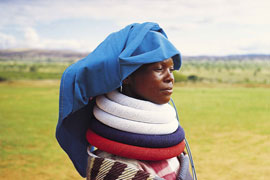 
Batwane Woman in Traditional Dress
Setswana is commonly known as Tswana, and it is Botswana’s national language. The majority of Tswana or Setswana speakers are however found in South Africa. It is the Northern Cape that is the source of the Setswana and Afrikaans speakers. When travelling to Zimbabwe and Namibia one is also able to bump into many Setswana speakers.
Being a Bantu language means Setswana is related to other Sotho languages. These are Southern Sotho and Sesotho-sa Leboa (Northern Sotho). Not long ago, Tswana was known by many as Beetjuans, Coana, Chuana (relation of Bechuanaland), Sechuana, Cuana. There seem to be a few of its own obstacles in the Tswana language when talking it, and this is because all of the Sotho languages have close relations with each other, moreover, there are different dialects found in certain parts of the African continent.
If you come across a Setswana speaker, be sure to say “Dumela!” This simply means “Hello!”. As with many other languages, Setswana has it own slang. Separate words: “O-a-re-eng?” is pronounced wah-reng simply means “How is it going?” an easier and much shorter version would be, “Go jwang”, and this simply means “How’s it?”
Wealth is measured among the Setswana speakers by the number of cattle they have in their possession. The more cattle a Setswana speaker owns, that person is moving closer to making “Setswana Forbes”. The Setswana Forbes is a list containing all the names of the wealthy. The division between a rich Setswana and a poor Setswana is distinct, and division continues to grow.
The world’s western ways have penetrated this culture, and this has led to the elimination of the Setswana speaker’s traditional clothing. However, many other cultures have survived this abolishment and they get to keep their traditional ways. Traditional healers, or sangomas, and music play a very important part in this culture.
The music involved in Setswana consists on only string instruments and human voices. The Setswana people don’t really use drums in their music, and this comes to no surprise, because only one musical group ever came into existence. The Kgwanyape Band released their album “Mepatho-ya Malobe” in 1993.
Many people question the credibility and the integrity of the sangomas of the Setswana people. There are arguments that these sangomas have no qualifications. Then again, there should not only be concerns about the Setswana sangomas, but sangomas in other cultures as well. If you are considering seeing a sangoma when travelling, keep in mind that travel and time for certain herbs are added to the fee. Most sangomas call on their ancestors when consulting you, so all you have to do is hope that the ancestors are smiling on that day.
        
|
| |
 
Southern Sesotho
This Bantu language originates from the Bantu-Nguni era and is also known as Suto, Souto, Sisutho as well as Suthu. The dialects originates from Suto, Pedi as well as Tswana which are intelligible but at the same time is also considered to be separate languages ...
Southern Sesotho Language
This Bantu language originates from the Bantu-Nguni era and is also known as Suto, Souto, Sisutho as well as Suthu. The dialects originates from Suto, Pedi as well as Tswana but at the same time is considered to be a separate language.
Being one of the eleven official languages of South Africa, Southern Sesotho is spoken by more than five million of the South African population as well as peoples in Lesotho, Botswana, Namibia and Zambia. In Lesotho, Southern Sesotho is one of the two official languages and is spoken by more than 85% of inhabitants. According to scholars, the original written form of this language was based on the dialect from Tlokwa and today it is mostly based on the dialects from the Kwena and Fokeng.
To describe the language is quite a task, as it is regarded to have nine vowels which are collapsed in five letters each. This, when compared to other languages of this nature is quite a large amount. The language consists of 35 consonants, which include two semi-vowels, for non-homogenous doubled eloquent and a tri-click.
Southern Sesotho would generally be classified in the group of the Niger-Congo family. While this complicated language will be a foreign tongue to you, when you do master and understand it when it is spoken, like all foreign languages, you will begin to appreciate the beauty thereof. The words have a flow to the sound when it is spoken by a Sesotho speaking person and one will easily pay attention to the intricacies in tone as well as the nasalization.
In this language, the words for father - ntate and mother - mme are also used to address elders and shows respect for them. Children are encouraged to have good manners, be polite and always have to be willing to know their values. The overall attitude that this culture has toward the growing youth is “Lefura la ngwana ke ho rungwa”, translated means, Children benefit from serving their elders.
Marriages are pre-arranged between families; which can lead to a girl being married as young as twelve. This has however changed with time and they are now free to pick their partners.
           
|
| |
Swati (Sewati / Swazi / siSwati) Language
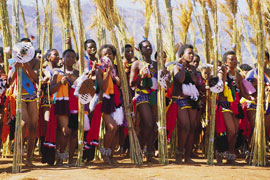 
Swazi Dancers
Swati might not sound familiar to you, but rather Sewati, Swazi or siSwati as these are all the same language, just in different names. Swati is a part of the Nguni Group and it is one of the many Bantu languages. It is mainly spoken by people in South Africa and Swaziland.
Swati one of the official languages of South Africa and many schools teach this language to the students only if they would like to learn it, while at other schools it is a compulsory subject to take. It is a similar language to Ndebele, Xhosa and Zulu and they are often confused by people that are unaware of the differences these four languages have.
Swati is easiest when divided into its four dialects, which are Hhoho, Nandzini, Shiselweni and Shiselweni again. These are the four divisions that correspond with the four appropriate districts of the country. There are mainly two different strains of the siSwati language. The normal kind of siSwati that is spoken is done so mainly in the South and North West, the other kind of Swati is mainly spoken far into the Deep South, this type is highly influenced by Zulu, so it is not really considered to be proper siSwati. Often considered to be the second dialect that is spoken is Swati.
During the year of 1750, the Swazi successors in South Africa decided to relocate, going north in the direction of KwaZulu Natal and then from there they went north-west in the direction of the Ususthu River. They chose to move to this river because it provided them with shelter and protection from the warriors and the King Shaka Zulu. They found it so enjoyable that there are still some Swazi’s staying there today.
The Swazi people are known to have many traditional events, but they are most commonly known for their Incwala and Umhlanga. At these events you will see the entire culture of Swazi’s in their colourful outfits with red feathers, carrying shields and wearing multicoloured necklaces. Another one of their great traditional festivals is the eight day reed dance (see photo above).
This is a ceremony held normally in the last days of August till the first few days of September for all the single women. All the unmarried women will do their dance for the Queen Mother and hand over the reeds that had specially cut for the occasion. The reason for this ceremony is to “protect the women’s chastity” and to praise the Queen Mother. On the last day of the celebration, the King will have his cattle slaughtered and the women may then help themselves to the meat and take it back home with them to enjoy further.
           
|
| |
 
Tsonga Language
 
Shangaan Woman
The language of Tsonga is mainly spoken throughout southern Africa by the Shangaan - Tsonga culture. The main area where Tsonga is spoken is in Zimbabwe, Mozambique, Swaziland and South Africa. Tsonga is a part of Bantu branch when it comes to the Niger-Congo languages.
The speakers of this language are often referred to as Shangaans, but the Tsongas say this is incorrect as that term should only be used for the Tsonga people who are living in Mozambique. Even though the Tsonga speakers are spread throughout Southern Africa, the majority of them live in the Limpopo province in South Africa. There are approximately 1,646,000 Tsonga speakers in Limpopo. Tsonga is one of South Africa’s eleven official languages as it is spoken by so many of its residents.
The language of Tsonga does not use the English alphabet, even though they are mainly based in South Africa, in actual fact they make use of the Latin alphabet. It is not an easy language to learn if you were not Tsonga born; they use specific sounds to spell, using a combination of different letters. The letters they use are not a part of the European language, but are just used to determine the language.
 
Nwe (1), Mbirhi (2), Nharhu (3), Mune (4), Ntlhanu (5), Ntsevu (6), Nkombo (7), Nhungu (8), Nkaye (9), Khume (10)
A few examples of what sentences look like when they are put together in Tsonga are like this;
“Va ndzi tiva” - They know me
“Ndza ku rhandza” - I love you
“Ha ku tiva” - We know you
“Wa ndzi rhandza” - You love me
Numerous dialects of the language Tsonga are used as far south as Kwazulu Natal and as far north as Zimbabwe, or the Save River in Zimbabwe. Most of the dialects are equally comprehensible, they do indeed have noticeable differences, which are geographical and based on the pressure from the colonial era. There are three popular distinct dialects, these are Xironga, which is mainly spoken in Maputo, the capital of Mozambique, as well as the areas around it; Chihlengwe / Xitshwa, verbal in Mozambique and Zimbabwe, and then xiTsonga, which is the language spoken in the country of South Africa. All of these dialects have different pronunciation, for example the Tsonga that’s spoken in South Africa, when they say “xi” it is pronounced as “shi”.
|
| |
      |
| |
|
| |
 |
| |
|
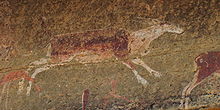

 Xhosa (isiXhosa) Language
Xhosa (isiXhosa) Language









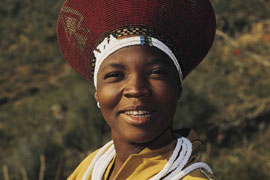























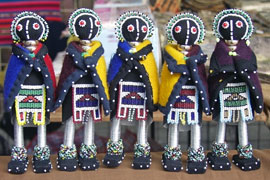





















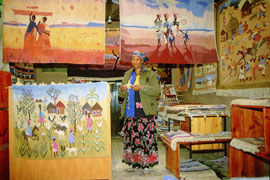






































































 Afrikaans Language
Afrikaans Language






 Around 666 000 of Tshivenda speakers live in the Northern parts of South Africa’s Limpopo Province. Those that speak Tshivenda have a Royal Family and there are also traditions that relate to this.
Around 666 000 of Tshivenda speakers live in the Northern parts of South Africa’s Limpopo Province. Those that speak Tshivenda have a Royal Family and there are also traditions that relate to this.  The people of Tshivenda show women the greatest respect, and because of this women are allowed to become Queens and Chiefs of their tribes. Followers show the Tshivenda women the same great respect, and in turn they show respect to their fellow males.
The people of Tshivenda show women the greatest respect, and because of this women are allowed to become Queens and Chiefs of their tribes. Followers show the Tshivenda women the same great respect, and in turn they show respect to their fellow males. 







